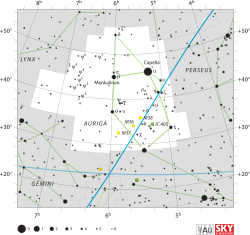
| |
| Observation data Epoch J2000 Equinox J2000 | |
|---|---|
| Constellation | Auriga |
| Right ascension | 05 32 43.67437 |
| Declination | +32° 11′ 31.2805″ |
| Apparent magnitude (V) | 4.74 |
| Characteristics | |
| Spectral type | B5 Iab |
| U−B color index | –0.44 |
| B−V color index | +0.32 |
| Astrometry | |
| Radial velocity (Rv) | –0.2 km/s |
| Proper motion (μ) | RA: −0.812 mas/yr Dec.: −3.15 mas/yr |
| Parallax (π) | 0.9087 ± 0.1906 mas |
| Distance | 3910±420 ly (1,200±130 pc) |
| Absolute magnitude (MV) | –6.4 |
| Orbit | |
| Period (P) | 676.85 ± 0.21 d |
| Eccentricity (e) | 0.116 ± 0.048 |
| Longitude of the node (Ω) | 181.7° ± 24.3° |
| Periastron epoch (T) | 2422754.2 ± 46.1 HJD |
| Semi-amplitude (K1) (primary) | 22.0 ± 2.9 km/s |
| Details | |
| Mass | 21.1±0.2 M☉ |
| Radius | 68±8 R☉ |
| Luminosity | 190,500+49,300 −39,200 L☉ |
| Surface gravity (log g) | 2.11±0.06 cgs |
| Temperature | 14,600±300 K |
| Rotational velocity (v sin i) | 40 km/s |
| Age | 8.7 Myr |
| Other designations | |
| χ Aur, 25 Aurigae, BD+32°1024, HD 36371, HIP 25984, HR 1843, SAO 58164 | |
| Database references | |
| SIMBAD | data |
Chi Aurigae, Latinized from χ Aurigae, is the Bayer designation for a binary star system in the northern constellation of Auriga. It is visible to the naked eye with an apparent visual magnitude of 4.74. The distance of Chi Aurigae is determined at 3,900 ly based on spectroscopic observations. Parallax measurements by the Hipparcos spacecraft were unsuccessful because the parallax error was bigger than the value itself, while the Gaia spacecraft measured the parallax with a 22% error, giving a distance of 3590±750 ly. The brightness of the star is diminished by 1.26 in magnitude from extinction caused by intervening gas and dust.
Chi Aurigae is a spectroscopic binary with an orbital period of 676.85 d and an eccentricity of 0.12. The primary component of this system is a supergiant star with a stellar classification of B5 Iab. It is over 190,000 times more luminous, around 20 times more massive and around 70 times larger. Its surface has an effective temperature of 14,600 K. It has a stellar wind that is causing mass loss at the rate of 0.38–0.46 × 10 solar masses per year, or the equivalent of the Sun's mass every 2.4 billion years.
References
- ^ Vallenari, A.; et al. (Gaia collaboration) (2023). "Gaia Data Release 3. Summary of the content and survey properties". Astronomy and Astrophysics. 674: A1. arXiv:2208.00211. Bibcode:2023A&A...674A...1G. doi:10.1051/0004-6361/202243940. S2CID 244398875. Gaia DR3 record for this source at VizieR.
- ^ Crawford, D. L.; Barnes, J. V.; Golson, J. C. (1971), "Four-color, H-beta, and UBV photometry for bright B-type stars in the northern hemisphere", The Astronomical Journal, 76: 1058, Bibcode:1971AJ.....76.1058C, doi:10.1086/111220.
- ^ Lesh, Janet Rountree (December 1968), "The Kinematics of the Gould Belt: an Expanding Group?", Astrophysical Journal Supplement, 17: 371, Bibcode:1968ApJS...17..371L, doi:10.1086/190179.
- Wilson, Ralph Elmer (1953), "General Catalogue of Stellar Radial Velocities", Carnegie Institute Washington D.C. Publication, Washington: Carnegie Institution of Washington, Bibcode:1953GCRV..C......0W.
- ^ Weßmayer, D.; Przybilla, N.; Butler, K. (2022-12-01), "Quantitative spectroscopy of B-type supergiants", Astronomy & Astrophysics, 668: A92, arXiv:2208.02692, Bibcode:2022A&A...668A..92W, doi:10.1051/0004-6361/202243973, ISSN 0004-6361
- ^ Raja, Tomas; Wolf, Marek (March 1998), "Hα variability of the B-type binary chi Aurigae", Astronomy and Astrophysics, 331: 550–556, Bibcode:1998A&A...331..550R.
- Abt, Helmut A.; Levato, Hugo; Grosso, Monica (July 2002), "Rotational Velocities of B Stars", The Astrophysical Journal, 573 (1): 359–365, Bibcode:2002ApJ...573..359A, doi:10.1086/340590.
- "* chi Aur". SIMBAD. Centre de données astronomiques de Strasbourg. Retrieved 2012-08-23.
- van Leeuwen, Floor (November 2007), "Validation of the new Hipparcos reduction", Astronomy and Astrophysics, 474 (2): 653–664, arXiv:0708.1752v1, Bibcode:2007A&A...474..653V, doi:10.1051/0004-6361:20078357, S2CID 18759600. Note: see VizieR catalogue I/311.
- Pourbaix, D.; et al. (2004), "SB9: The ninth catalogue of spectroscopic binary orbits", Astronomy and Astrophysics, 424 (2): 727–732, arXiv:astro-ph/0406573, Bibcode:2004A&A...424..727P, doi:10.1051/0004-6361:20041213, S2CID 119387088.
- Prinja, R. K.; Massa, D. L. (October 2010), "Signature of wide-spread clumping in B supergiant winds", Astronomy and Astrophysics, 521: L55, arXiv:1007.2744, Bibcode:2010A&A...521L..55P, doi:10.1051/0004-6361/201015252, S2CID 59151633.
External links
| Constellation of Auriga | |||||||||||||
|---|---|---|---|---|---|---|---|---|---|---|---|---|---|
| Stars |
| ||||||||||||
| |||||||||||||
| Star clusters |
| ||||||||||||
| Nebulae |
| ||||||||||||
| |||||||||||||
| |||||||||||||